1920s Garden Ideas: Vintage Charm for Modern Homes
The 1920s was a vibrant decade filled with dynamic changes, and these shifts extended to garden design. Gardens became more than just places to plant flowers; they transformed into extensions of the home, showcasing style and elegance. Are you curious about how people brought creativity and flair to their outdoor spaces a century ago?
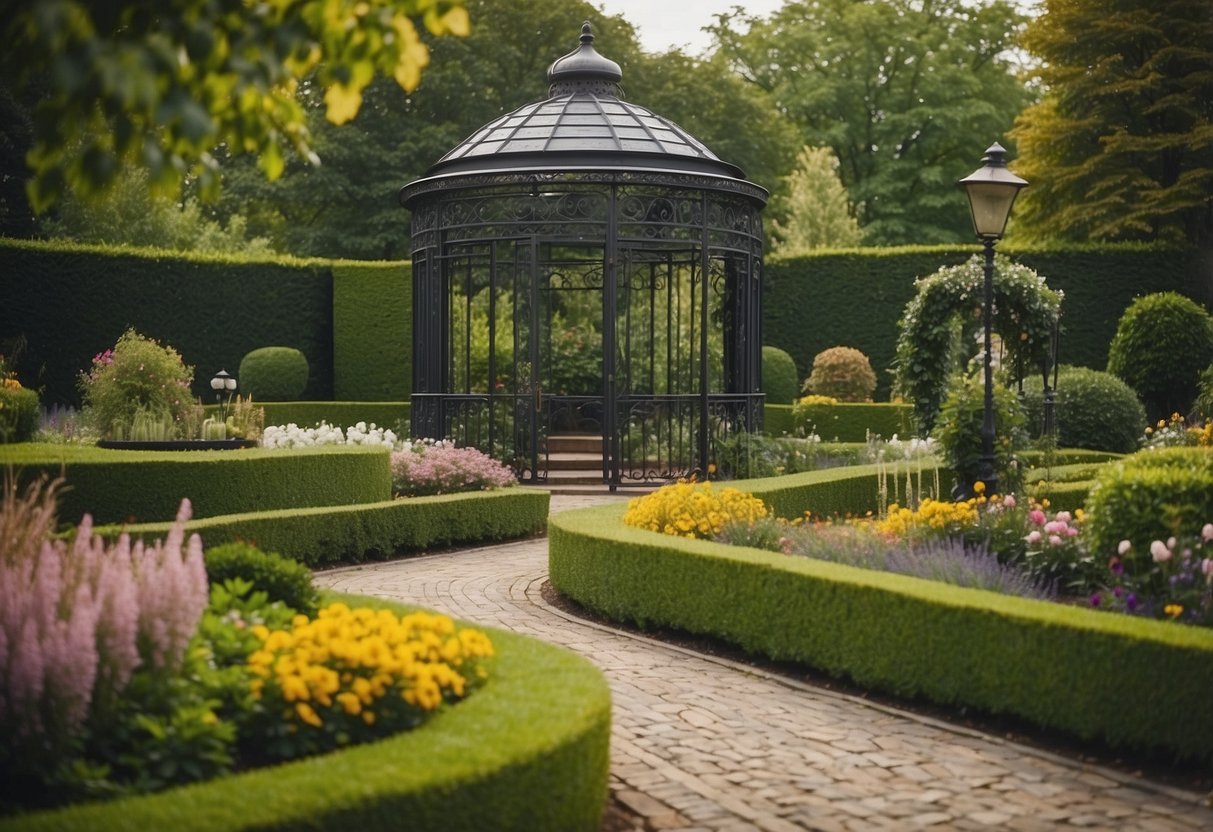
During this time, gardens were designed to be places of beauty and relaxation, integrating unique elements that reflected the trends of the era. Whether you’re looking to infuse a touch of vintage charm into your garden or simply enjoy historical design, understanding the 1920s garden ideas can provide wonderful inspiration.
1) Vertical Wall Gardens
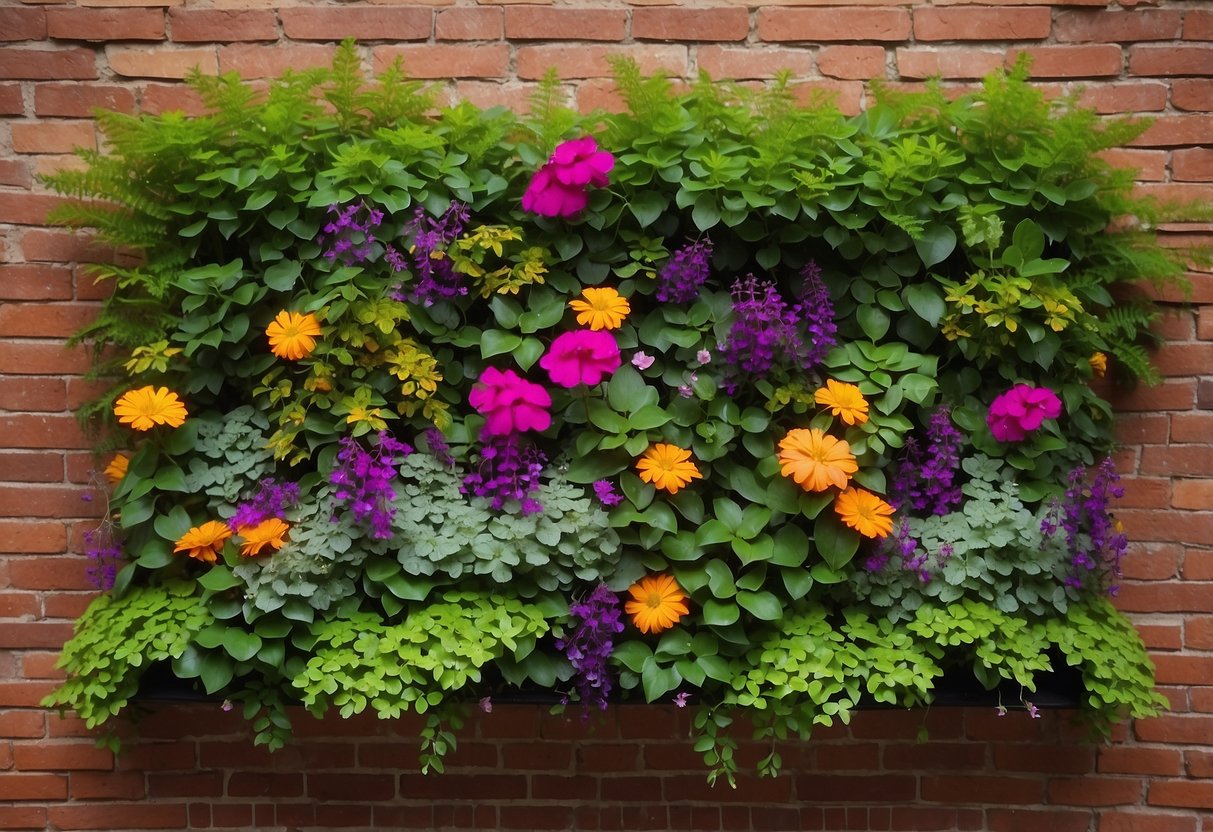
Vertical wall gardens are perfect if you want to maximize your gardening space.
You can easily create a vertical garden by adding planters to a wall or fence. Try building a slat wall and placing planters on it for an attractive design.
Another idea is to use pallet garden walls or vertical bottle planters, which are both simple and cost-effective projects. These setups can help you grow fresh herbs, flowers, or even small vegetables right on your wall.
2) Rustic Stone Pathways
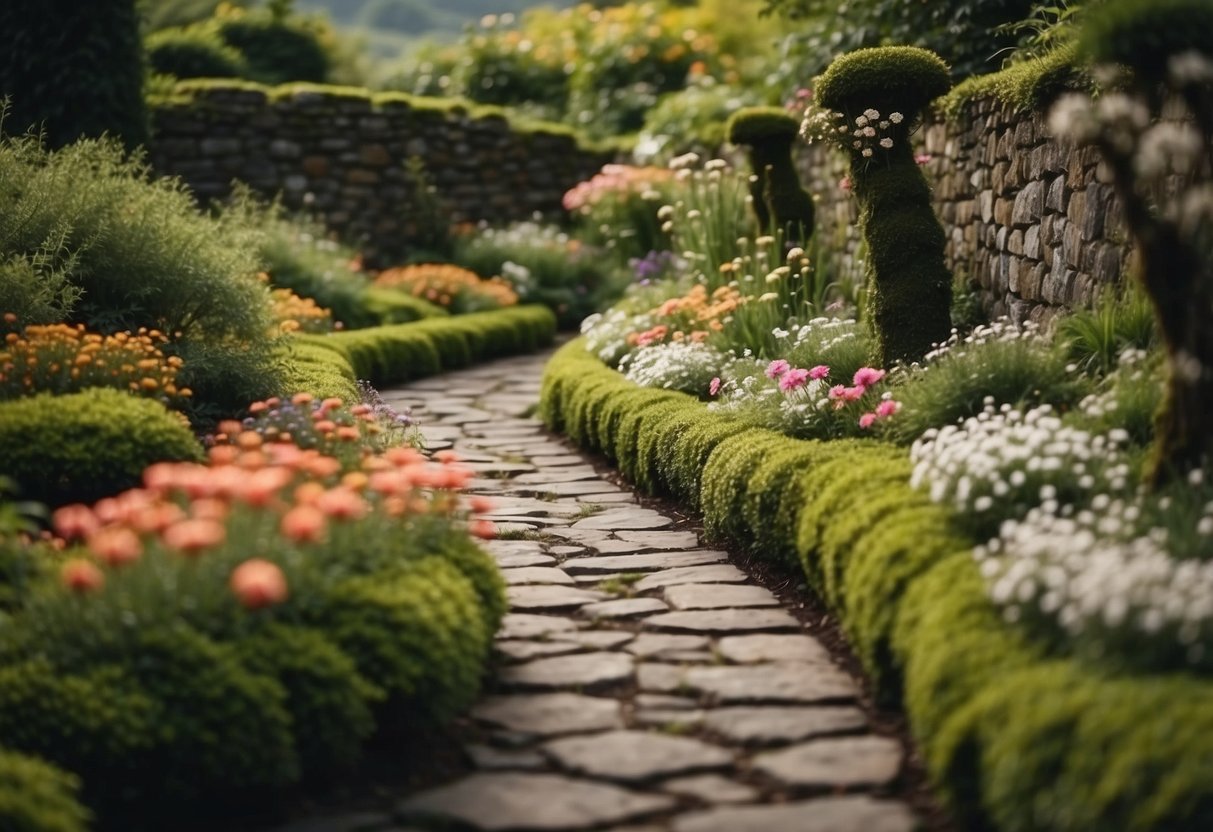
In the 1920s, rustic stone pathways were very popular in garden designs. These pathways often used flagstones or cobblestones.
You can add charm to your garden with a curved path. Stones like flagstone create a natural, inviting look. A flagstone pathway can lead through lush greenery, adding a touch of the past to your yard.
Circular designs were also common, connecting different areas of the garden. This type of rustic pathway creates a sense of both order and whimsy in your garden.
3) Fairy Light Accents
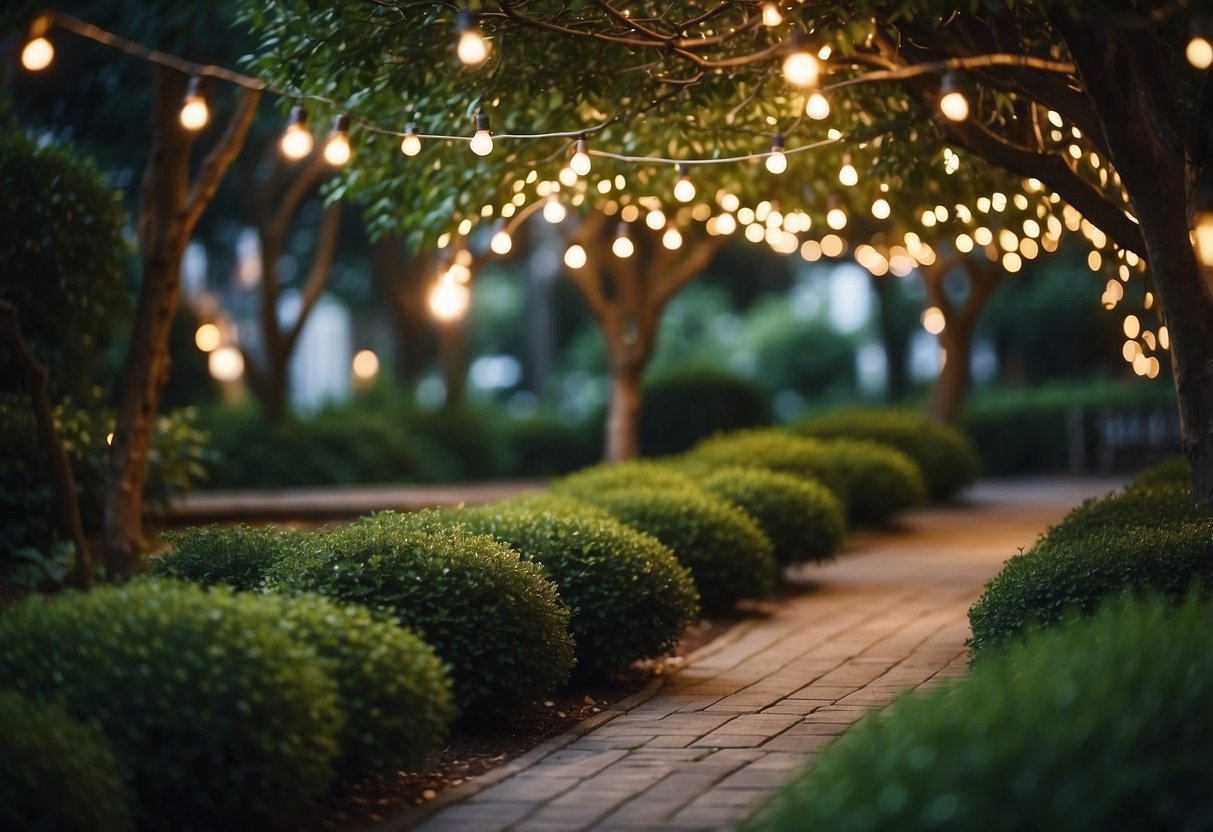
Adding fairy lights to your 1920s garden party can enhance the magical atmosphere. String them along trees, bushes, or even wrap them around trellises.
Place fairy lights in mason jars and position them on tables or hang them from branches. They create a warm and inviting glow, perfect for evening gatherings.
Fairy lights also look great when draped across fences or arbors. They can highlight garden paths and make your outdoor space feel cozier.
4) Vintage Bird Baths
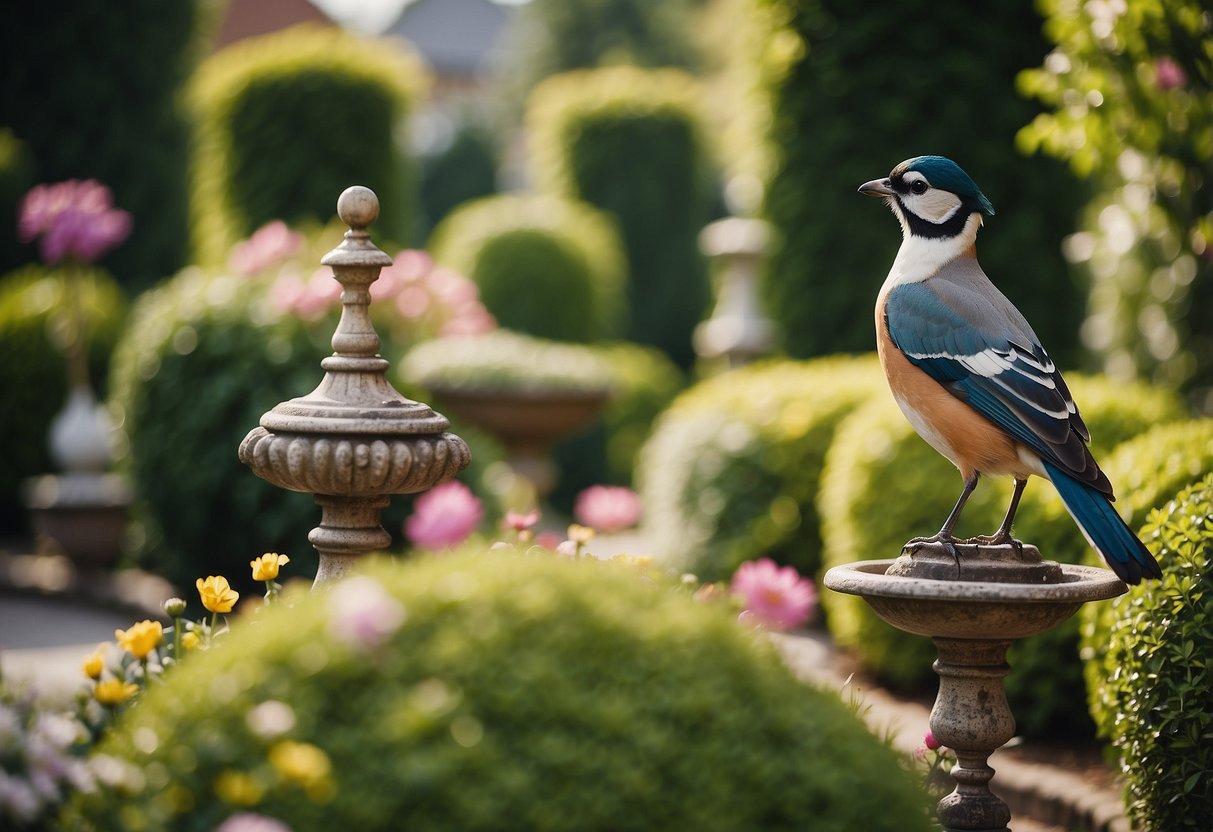
Adding a vintage bird bath can give your garden a charming, old-world feel. Imagine a classic hammered metal bird bath made of copper or aluminum to add a touch of vintage Americana charm to your landscape.
You could also use a porcelain bird bath as a unique garden decor. These antique pieces often feature intricate designs and create a focal point in your garden.
For something truly unique, consider repurposing an old bird bath. With a bit of creativity, you can transform it into a beautiful garden centerpiece. Try adding plants or flowers for an added touch of elegance.
5) Sculptural Hedges
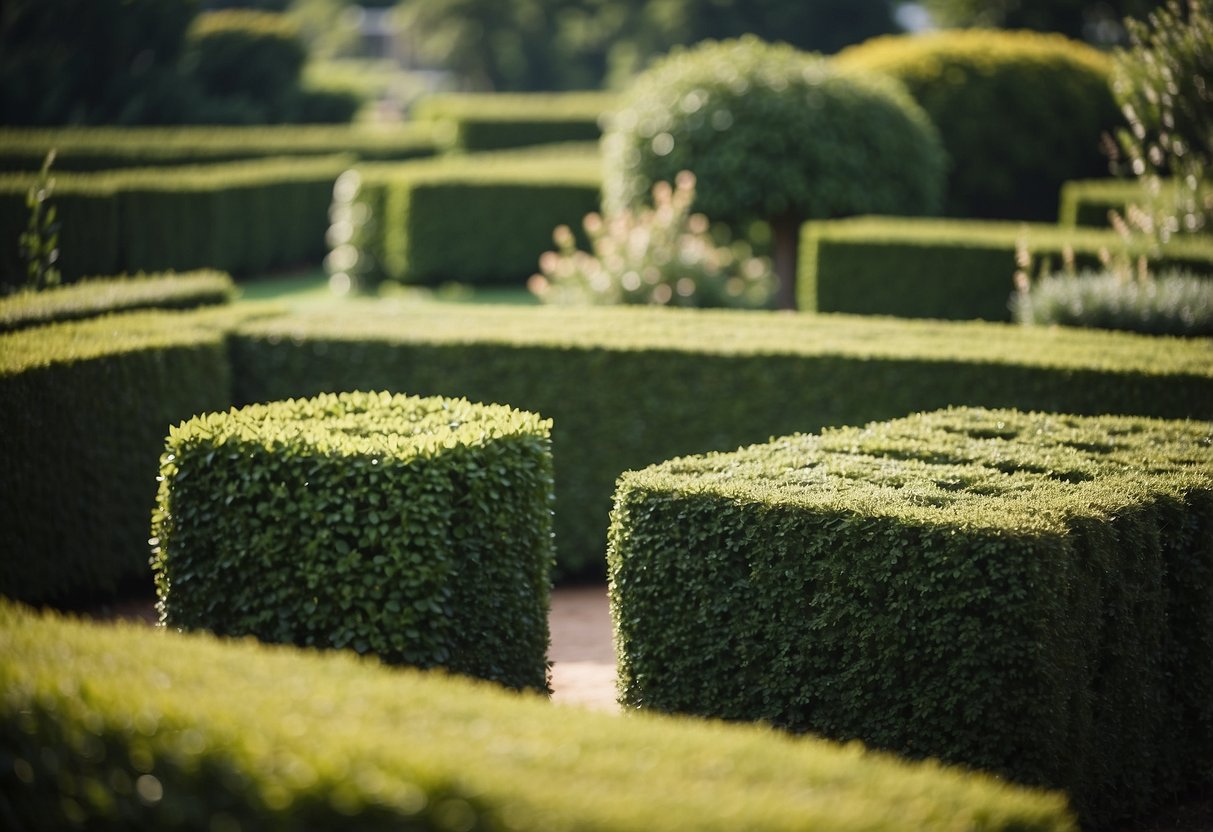
Sculptural hedges are a fantastic way to add a unique touch to your 1920s-inspired garden. These hedges can be trimmed into various shapes, such as animals, geometric forms, or even abstract art.
You can use plants like boxwoods and yews that are easy to shape. These plants grow dense foliage, making it easier for you to create precise designs.
Adding sculptural hedges to your garden not only enhances its beauty but also brings a playful and artistic element into your outdoor space.
6) Solar-Powered Garden Lights

Solar-powered garden lights are a great way to add charm to your outdoor space while being eco-friendly. These lights charge during the day and automatically light up when it gets dark.
You can drape fairy lights over fences or shrubs for a magical touch. For a quirky twist, add a solar-powered robot statue that lights up at night.
A DIY tin can solar lantern can be a fun project too. Decorate your garden while keeping energy costs down with these creative and practical ideas.
7) Succulent Arrangements

Succulents bring a modern touch to any garden. By choosing a variety of shapes and sizes, you can create visually appealing designs. Place taller succulents toward the back and smaller ones in front for a layered look.
Consider using unusual items like vintage radios or hanging baskets for a unique twist. A container arrangement can also be striking when using contrasting colors and textures. For small spaces, try a rain gutter garden to keep things tidy and stylish.
8) Perennial Flower Beds
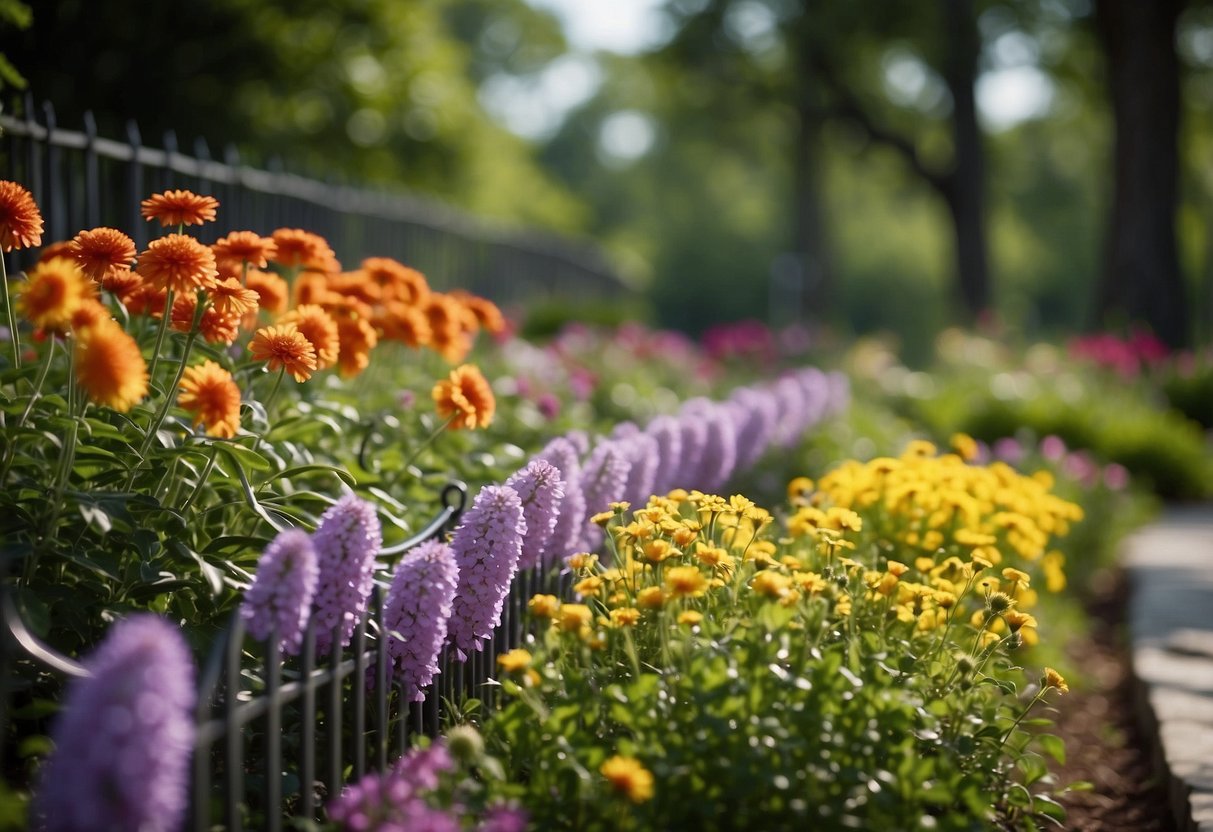
Adding perennial flower beds to your garden can create a vibrant and lasting display of color. Perennials bloom year after year, making them a great investment for your 1920s-themed garden.
Incorporate plants like purple coneflower and chrysanthemums to enjoy flowers season after season. These flowers add variety and charm to your garden space.
Consider using tree stumps as flower beds for a rustic touch. Tree stumps provide a natural planter for your perennials, maintaining soil moisture effectively. This idea is both eco-friendly and visually appealing.
9) Vegetable Planter Boxes
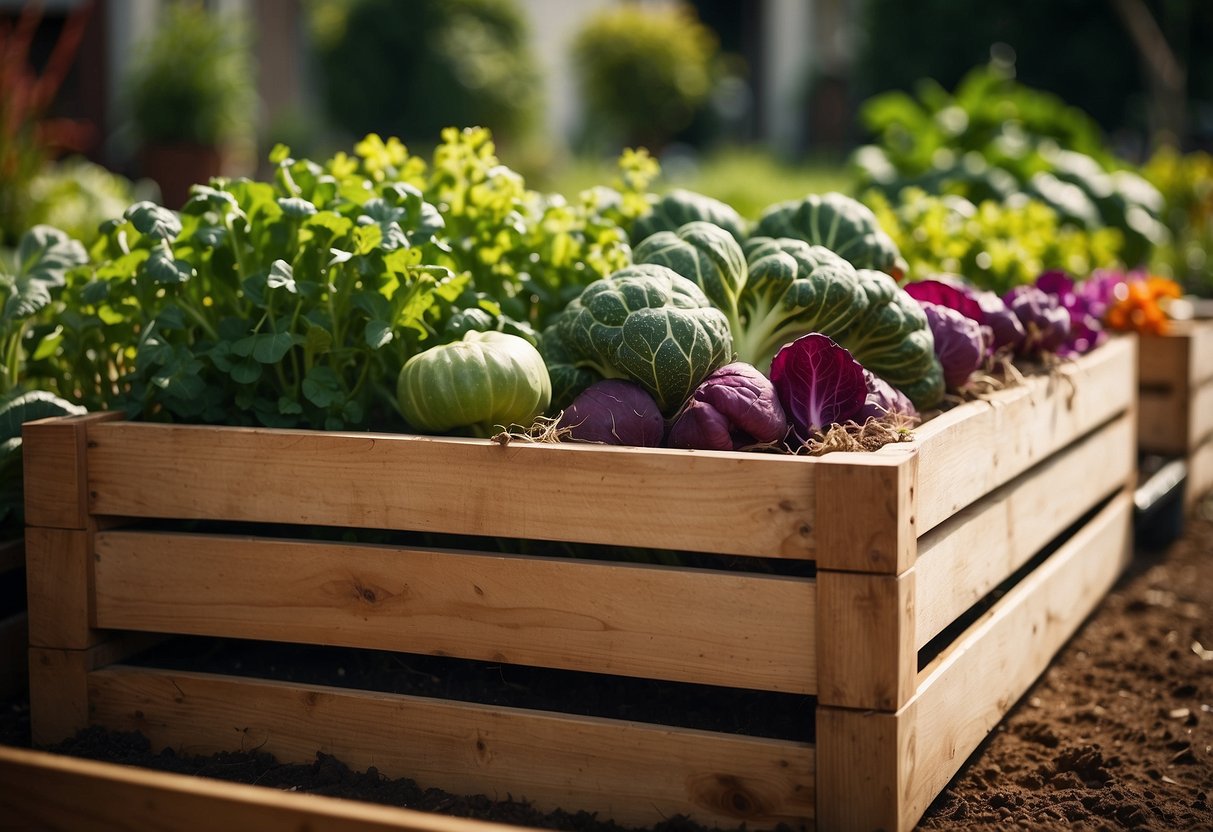
Vegetable planter boxes are perfect for growing fresh produce at home. You can place them on patios, balconies, or even rooftops.
Use sturdy boxes with good drainage. Fill them with high-quality soil. Plant veggies like tomatoes, peppers, and lettuce.
Keep them in sunny spots and water regularly for the best results. Try using organic fertilizers to boost growth.
10) Bamboo Privacy Screens
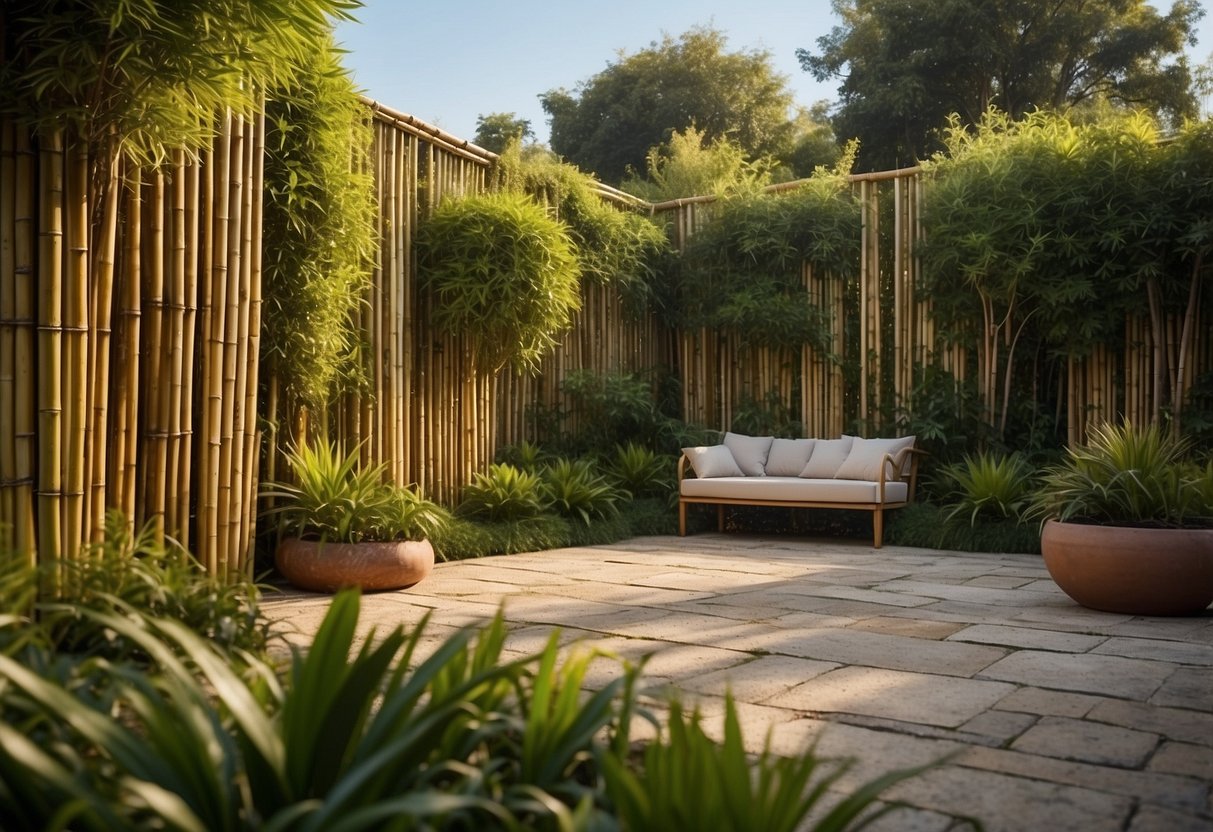
Bamboo privacy screens are a great addition to any garden. They not only offer privacy but also add a touch of natural beauty to your space.
You can easily make a DIY bamboo privacy screen by using bamboo fencing and some basic tools. It’s a simple project that can transform your garden quickly.
Attach bamboo panels to a wooden frame or secure them with hooks and brackets. This allows you to create a serene and private area in your garden. Bamboo is durable and weather-resistant, making it perfect for outdoor use.
11) Garden Gnome Statues

Adding garden gnome statues can give your 1920s-inspired garden a whimsical touch. These statues are fun and bring character to your garden space.
You can place them among your flowers or by small paths to create a magical feel. There are many styles to choose from, like classic gnomes or those holding tiny tools.
You might even consider painting your own gnome statues. This adds a personal touch and makes each gnome unique. It’s a simple way to add charm to your garden.
12) Hanging Herb Gardens
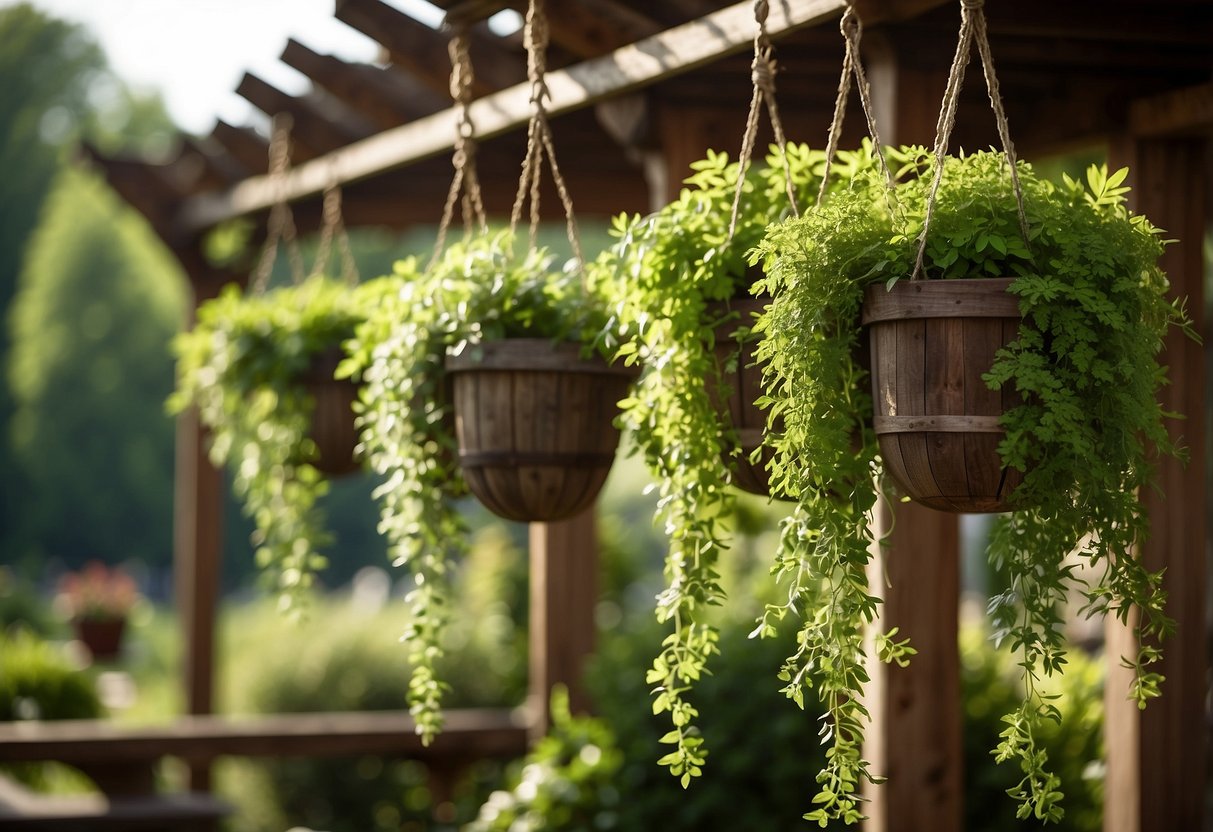
Hanging herb gardens can bring a touch of the 1920s charm to your space. They save room and offer fresh herbs right at your fingertips. You’ll love the practical and aesthetic benefits.
You can create one with simple materials like wooden planks and metal buckets. For inspiration, check out these creative hanging herb garden ideas for urban dwellers.
Hanging your herbs can make your garden feel more open. Plus, it’s a great conversation starter!
13) Waterfall Features
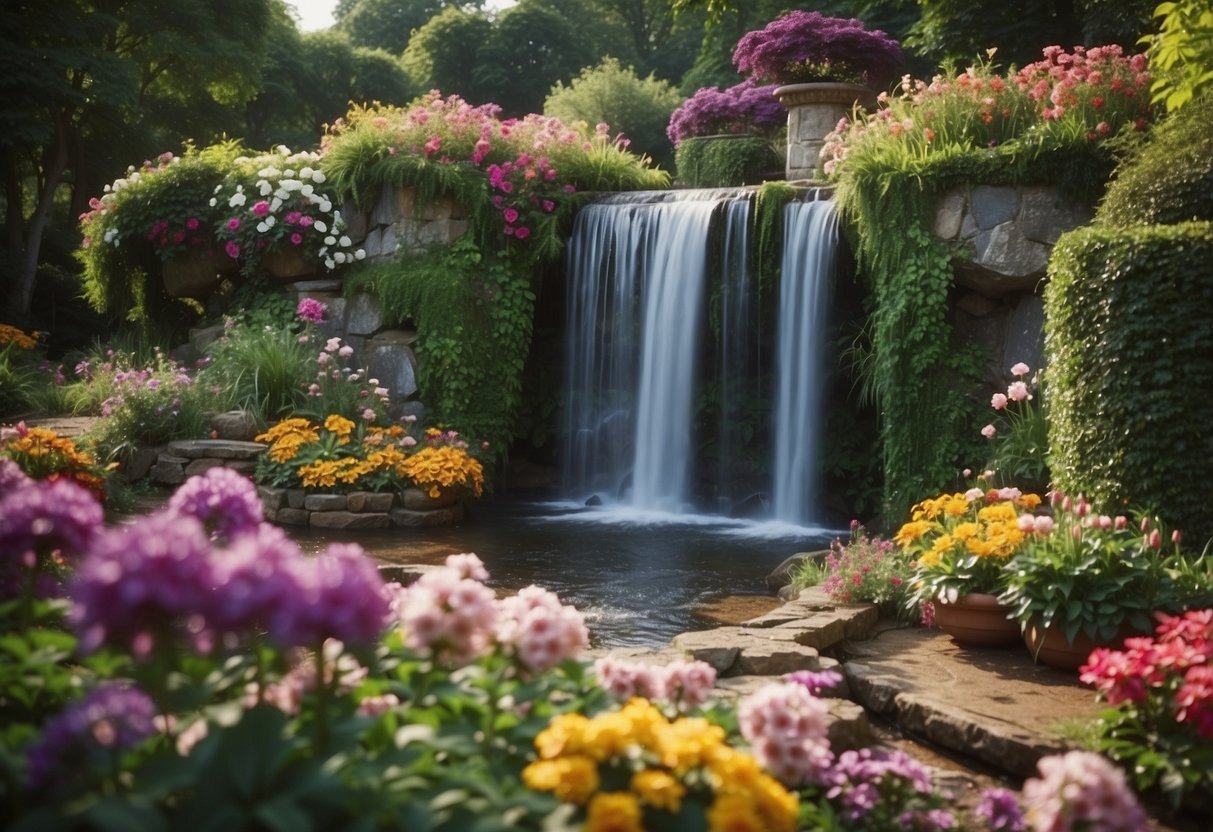
Adding a waterfall to your garden creates a calming atmosphere. The sound of water flowing can be very soothing. You can build a small waterfall using stones even if you have limited space.
Waterfalls can be part of a pond or standalone features. They blend well with plants and rocks, making your garden feel more natural. You might get ideas for your waterfall design by looking at different styles and materials.
Using waterfalls in your garden can also attract birds and butterflies, adding even more life to your outdoor space. Your garden can become a peaceful retreat right at home.
14) Outdoor Rugs
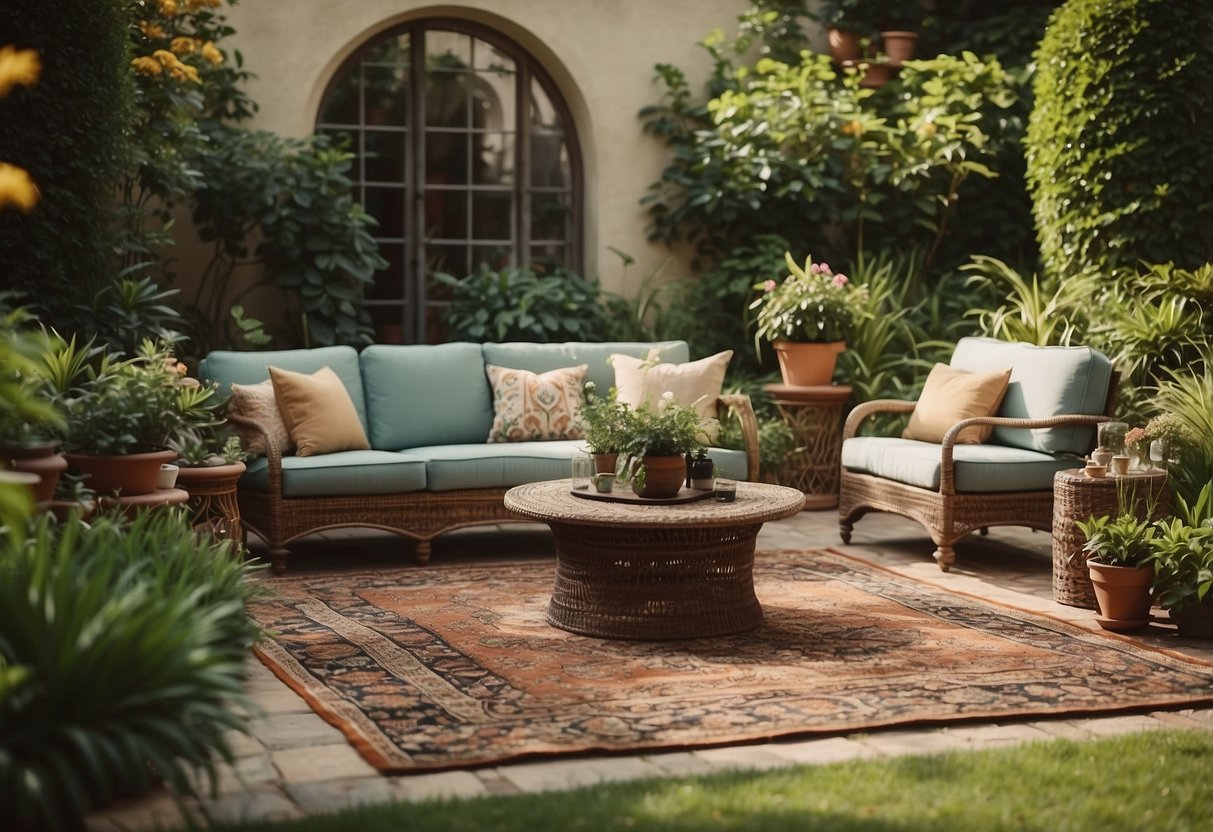
Outdoor rugs can transform your garden into a cozy and inviting space. They add color, style, and comfort, making it feel like an extension of your home.
By choosing weather-resistant materials, you ensure that your rug stands the test of time. Patterns and designs can reflect the charm of the 1920s, adding a touch of vintage elegance.
Outdoor rugs are also practical. They provide a soft surface to walk on and can help define different areas in your garden, such as dining or lounging spaces. Consider adding one to elevate your garden’s aesthetic.
15) Colorful Mosaic Stepping Stones

Adding colorful mosaic stepping stones to your garden brings a splash of art and creativity. You can use a variety of materials like glass, tiles, and broken pottery to create vibrant patterns.
These stepping stones are not only beautiful but also functional, guiding visitors through your garden in a visually appealing way. They can be customized with different shapes and colors.
Making these stepping stones can be a fun DIY project for the whole family. Just prepare the stepping stone, as suggested by Midwest Living, and get creative with your designs.
16) Modern Fire Pits

Modern fire pits create a cozy and stylish outdoor space. Many designs feature sleek lines and modern materials like metal and stone. You can find various options on sites like Houzz.
Adding a fire pit to your garden can make it a hub for gathering. Choose ones with a wide lip, perfect for resting drinks, as suggested on Architectural Digest. It’s a great way to mix functionality with design.
17) Outdoor Sectional Sofas
Outdoor sectional sofas can transform your garden into a cozy living space. These sofas offer ample seating for guests and family, making gatherings more enjoyable.
If you want a DIY project, consider a one-arm outdoor sectional sofa. It’s a fun and easy project that adds style and function to your garden. Learn how to build it with this guide on outdoor sectionals.
Using materials like cedar fence planks can give your sectional a charming, natural vibe. Vibrant cushions can add a pop of color and make the space inviting. Get inspired by ideas from Gray House Studio.
18) Pergolas with Climbing Roses

Using pergolas with climbing roses adds a lovely charm to your garden. These structures create a beautiful, shaded area perfect for relaxation.
Choose fragrant varieties like Cecile Brunner or Lady Banks. Place your pergola in a sunny spot; roses need plenty of sunlight to thrive.
These pergolas can turn any outdoor space into a romantic, picturesque getaway.
19) Painted Garden Chairs

Painted garden chairs can add a vibrant touch to your outdoor space. You can use bold colors like red, turquoise, or green to create a striking focal point.
Experiment with patterns such as polka dots, stripes, or florals. This can give your garden a cheerful and lively feel.
Don’t be afraid to mix and match different styles of chairs to create a unique look. For more ideas, check out these creative uses for garden chairs.
20) Copper Wind Spinners

Adding copper wind spinners to your garden can bring some charm and movement to your outdoor space. These spinners often shimmer in the sunlight and turn gracefully with the breeze.
Enhance your garden with unique pieces like copper wind spinners from platforms such as Etsy. These are perfect for adding a touch of elegance to your outdoor decor.
21) Terrarium Displays

Terrarium displays were a charming and unique feature in 1920s gardens. These small, enclosed gardens allowed you to bring a bit of nature indoors.
Using clear glass containers, you can create beautiful scenes with small plants, soil, and decorative elements. This adds a touch of greenery to any room in your home.
Terrariums can feature various themes, from desert landscapes with succulents to lush, jungle-like setups with moss and ferns. You can even add miniature decorations to create whimsical fairy gardens.
Find inspiration and ideas for your terrarium from this collection. This will help you create your little indoor paradise.
22) Birdhouse Collections

Adding birdhouses can make your garden charming and inviting. You can display them on old ladders, paint stair spindles, or use copper pipes as poles.
Birdhouses will attract nesting birds, adding life to your garden. They come in various styles, from rustic to modern.
Avoid using toxic products near your birdhouses to protect the birds and their food sources. For more creative birdhouse ideas, visit Empress of Dirt.
23) Garden Teepees

Garden teepees are a fun and practical way to add structure to your garden. They are especially useful for growing climbing plants like beans, cucumbers, and peas.
You can easily make a garden teepee using bamboo stakes or branches. Simply arrange the poles in a circle and tie them at the top with garden twine.
Garden teepees not only support your plants but also create a charming focal point in your garden. They are simple to construct and take up minimal storage space when not in use. For more ideas, check out this guide.
24) Lavender Borders

Lavender borders bring charm and fragrance to your garden. The plants are hardy perennials and need little maintenance.
To create a stunning effect, plant lavender in well-drained soil and full sun. Lines of lavender along pathways or garden edges enhance the garden’s beauty.
Lavender also attracts pollinators like bees and butterflies, adding life to your garden.
For more ideas, check out this lavender border guide.
25) Antique Garden Benches

Antique garden benches can add charm and history to your garden. These benches often feature intricate designs and are made from durable materials like wrought iron or wood.
Look for benches with unique details such as decorative scrollwork or patina finishes. These elements give character and create a focal point in your outdoor space.
You can find antique garden benches at flea markets, antique shops, or online. They not only provide seating but also enhance the beauty of your garden with their timeless appeal.
26) Butterfly Gardens

Butterfly gardens in the 1920s were not just functional, they were enchanting. To attract butterflies, you need to plant nectar-rich flowers like milkweed, coneflowers, and lavender. These plants provide food for both adult butterflies and caterpillars.
Place your garden in a sunny spot. Butterflies thrive in the sun. Grouping plants in clusters makes it easier for butterflies to spot them.
Avoid pesticides to keep your garden organic and safe. This way, you create a haven for butterflies to flourish.
27) Tiered Water Fountains

Tiered water fountains were popular in the 1920s and can add a charming touch to your garden today. These fountains usually have multiple levels where water cascades from one tier to the next, creating a soothing sound.
Tiered fountains can be made from materials like stone, marble, or concrete. They work well as a focal point in any garden, surrounded by lush plants and flowers.
Consider adding ferns or hydrangeas around the base of the fountain for a classic look. For more ideas, you can visit this collection of tiered fountains.
28) Pallet Planters

Pallet planters are a creative way to add a vintage touch to your garden. You can easily upcycle old wooden pallets into charming garden features.
Turn a pallet into a vertical herb garden by attaching small pots or fabric pockets. It’s perfect for growing herbs for your kitchen.
Another idea is to make staggered horizontal planters by stacking pallets and filling them with soil. This gives a layered look for growing flowers and small plants. For more ideas on how to create these, check out these amazing DIY pallet garden ideas.
29) Vintage Garden Tools Display

Using vintage garden tools for a display adds a charming touch to your outdoor space.
You can hang old shovels, rakes, and hoes on a wooden fence or a wall. This creates an eye-catching and rustic art piece for your garden.
Consider using wooden crates or pallets to showcase smaller tools like hand trowels and pruners.
30) Fruit Tree Espaliers

Fruit tree espaliers are a fantastic addition to your 1920s garden.
These trees are trained to grow flat against a wall or fence. This method saves space and adds a touch of elegance.
For warmer climates, consider figs, pomegranates, and citrus trees. Apples and pears are also popular choices.
Espaliered trees provide beauty and fresh produce, enhancing your garden’s charm.
31) Japanese Zen Gardens
Japanese Zen gardens, also known as Karesansui, feature simple and elegant designs.
These gardens use rocks, gravel, and sand to create a calming space.
A gently babbling water feature can add to the relaxing atmosphere.
You can also include plants like bonsai and moss to enhance the natural feel.
Creating a peaceful retreat in your backyard is easier with these minimalist ideas.
32) Mediterranean Styled Terracotta Pots
Mediterranean styled terracotta pots add charm and warmth to your garden. Their earthy tones match beautifully with green plants.
You can use these pots to grow herbs, flowers, or even small shrubs. They are perfect for adding a touch of the Mediterranean to patios or balconies.
Arrange them in groups of different sizes for more visual interest. Your garden will feel like a sunny Mediterranean escape.
33) Garden Bridges
Adding a garden bridge can bring a touch of charm and elegance to your backyard. Whether it’s a classic wooden arch bridge or a small, stone bridge, these structures can enhance the beauty of your garden.
A wooden bridge over a small pond creates a rustic feel that blends seamlessly with nature. It’s a great way to add visual interest and practical walkways to your garden.
Stone bridges are durable and have a timeless look. They can span a creek or become a focal point in your garden. Look for unique designs that match your garden’s style for the best effect.
For more on different styles, you can explore these garden bridge ideas or see more incredible garden bridge designs.
34) Hammock Swings
Hammock swings bring a charming touch to any 1920s-style garden. They offer a unique way to relax while enjoying the outdoor scenery.
Look for swings with crochet or fringe details for that authentic vintage feel. Adding a few colorful pillows can make your hammock swing both comfortable and stylish.
Placing the swing between two trees or on a sturdy frame creates a cozy nook. In the evenings, draping string lights above can create a magical ambiance, perfect for unwinding.
35) Heirloom Tomato Varieties
Heirloom tomatoes come in a variety of shapes, colors, and flavors. You can find over 400 types. Each one has its own unique taste and look.
Some popular ones include the Brandywine, known for its robust flavor. Another favorite is the Green Zebra, with its striking green stripes.
Heirlooms are open-pollinated. This means you can save the seeds and grow them year after year. They are also known for their vigorous growth and tasty fruits. For a colorful option, try Amana Orange or Kellogg’s Sunset. Enjoy experimenting with different heirloom varieties in your garden!
36) Garden String Lights
String lights bring a magical touch to your garden. They can be hung from trees or draped along fences. You can create a warm and inviting atmosphere.
Use various styles like fairy lights or Edison bulbs. They can make outdoor gatherings cozy and fun.
For a modern look, hang them in geometric patterns. String lights are versatile and easy to set up.
37) Treehouse Retreats
Imagine relaxing in a cozy treehouse nestled among the trees. A treehouse retreat can make your garden feel like an escape.
Building a treehouse in your garden is a fun project. Choose strong trees for the base and use wooden materials for a natural look.
Consider adding elements like a small porch or windows to enjoy the views. Treehouse retreats bring a sense of adventure and tranquility to your outdoor space. For more inspiration, check out these treehouse ideas.
38) Pollinator-Friendly Plants
Your garden can become a haven for pollinators with the right plants. Blue Vervain, with its small spikes of purple flowers, is perfect for attracting birds, butterflies, and bees.
Consider adding Shasta daisies and goldenrod, which support a variety of pollinators like bees and butterflies. Zinnias are also great for attracting hummingbirds to your garden.
39) Recycled Glass Garden Edging
Using recycled glass bottles for garden edging is a fantastic way to add some charm to your garden. Glass bottles come in various colors, which can create beautiful patterns and borders.
To start, collect several glass bottles. You can use wine, soda, or any bottles you have at home.
Bury the bottles neck-down into the soil. Make sure they are securely placed close together to form a solid border. This not only looks whimsical but also helps keep soil and mulch in place.
For added stability, you can dig a shallow trench. This makes sure the bottles stay in position even during rain.
40) Meditation Nooks
Create a cozy spot in your 1920s garden for meditation. Choose a quiet corner and add comfortable seating like a bench or a cushion.
Decorate the space with simple plants, such as lavender or ferns, which offer calming aromas. You can also add a small water feature to enhance relaxation.
Consider incorporating wind chimes to bring soothing sounds into the nook. A couple of well-placed rocks or pebbles can give it a peaceful, Zen-like feel.
41) Garden Whimsical Statues
Garden whimsical statues can add a touch of magic to your outdoor space. Imagine small fairy figures hiding among the flowers or gnome statues peeking out from behind bushes.
You can also include animal statues, such as playful rabbits or curious birds. These charming pieces make your garden feel like a secret, enchanted place.
Consider placing these statues in unexpected spots. This way, every visit to your garden becomes an adventure.
42) Blue Hydrangea Bushes
Blue hydrangea bushes can add a touch of elegance to your 1920s-style garden. Their colorful blooms create a striking contrast against green foliage.
Blue hydrangeas thrive in areas with morning sun and afternoon shade. They prefer well-draining, fertile soil with a pH below 6.5 to maintain their blue color.
Compact varieties like the ‘Pop Star’ and ‘Blue Enchantress’ grow to about 3-5 feet high. They are a great choice for small spaces or garden borders. If you want a low-maintenance option, consider the ‘Penny Mac’ variety, known for its easy care and quick growth.
43) Koi Fish Ponds
In the 1920s, koi fish ponds became a popular garden feature. These ponds add a touch of elegance to any garden.
Consider adding aquatic plants like lotus flowers and water lilies. They produce oxygen and provide shade for the fish.
You might also enjoy the soothing sounds of a waterfall. It helps keep the water fresh and reduces algae growth.
44) Patio Container Gardens
Patio container gardens are a fantastic way to bring color and life to your outdoor space. They’re perfect for small areas and add a delightful touch.
You can use containers to grow a mix of flowers, herbs, and even small vegetables. Try pairing vibrant flowers with aromatic herbs for a lovely effect.
Consider using colorful pots and varying heights to create visual interest. For some inspiration, take a look at these creative container garden ideas. Your patio will bloom beautifully!
45) Edible Flower Beds
Edible flower beds combine beauty with practicality. You can grow colorful flowers that also serve as ingredients for your kitchen.
Think about planting nasturtiums, which are perfect for salads and garnish. Add some lavender for its beautiful blooms and lovely scent. Lavender can also be used in teas and desserts.
Integrate edible herbs like rosemary, mint, and thyme. These not only enhance the visual appeal but also provide fresh flavors for your meals.
46) Pergolas with Wisteria
Adding Wisteria to your pergola can give your garden a timeless, elegant look. Wisteria is a climbing plant known for its cascading flowers and lush green leaves.
To train Wisteria, gently tie the shoots to your pergola using soft garden twine or ties. This supports their growth and helps them climb the structure.
Make sure to prune the Wisteria regularly. Pruning helps control its growth and encourages more flowers. Enjoy the beauty and fragrance of a Wisteria-covered pergola in your garden.
For more tips, visit Wisteria and Pergolas.
47) Brick Pizza Ovens
Adding a brick pizza oven to your garden can be a fun and tasty project. These ovens are popular for their unique ability to cook delicious, crispy pizzas right in your backyard.
Building a brick pizza oven may take some time and effort. You can find guidance and inspiration from the Totsline Family’s DIY project or consider purchasing a DIY kit like the Milano 750.
A well-made brick pizza oven can become a great gathering spot, making your garden not just beautiful, but also a place where tasty memories are made.
48) Topiary Gardens
Topiary gardens are a delightful way to add structure and fun to your yard. This art involves shaping your plants through careful trimming.
You can start with simple shapes like cubes or spheres. These are great for dividing different areas in your garden.
Evergreens like boxwoods are popular choices for topiary. They stay green year-round and are easy to shape.
For inspiration, you can check out some classic examples of topiary gardens.
49) Willow Fences
Willow fences can add a magical touch to your 1920s-style garden. These living fences are created using willow rods. You can plant the rods directly into the ground.
Choose a sunny spot with moist soil for the best growth. Make sure it’s away from any drains or structures to prevent damage.
Willow fences are not just beautiful but also environmentally friendly. They provide a natural screen and blend seamlessly into a garden. Whether it’s a simple fence or an intricate design, a willow fence can enhance your garden’s charm.
50) Seasonal Floral Displays
Adding seasonal flowers to your garden can bring vibrant colors throughout the year. Using vintage containers like galvanized buckets or wooden crates can enhance the charm.
For spring, think tulips and daffodils.
Summer shines with roses and sunflowers.
In the fall, mums and asters take center stage.
Winter’s beauty can come from evergreens and holly.
Mix perennials with your seasonal picks to keep your garden interesting all year round.
51) Tile Garden Tables
Tile garden tables bring a splash of color and style to your outdoor space. The patterned tiles on the table surface create a unique and eye-catching look.
You can choose tiles that match your garden’s theme or go for bright, bold colors to make a statement.
These tables are not only beautiful but also durable and easy to clean, making them perfect for any garden setting.
Find inspiration for your tile garden table from a variety of design ideas to suit your space.
52) Climbing Vine Trellises
Climbing vine trellises are an excellent way to add vertical interest to your garden. They are especially popular in 1920s garden designs.
You can use materials like bamboo or willow to create a natural look. A woven willow trellis adds a whimsical touch to your garden.
For a more structured appearance, try a diamond-patterned trellis. This pattern is ideal for wrapping ivy or flowering vines around fences or walls.
53) Subtle Garden Lighting
To create a cozy and inviting 1920s garden, think about using subtle lighting. Instead of bright, harsh lights, choose soft, muted options that highlight your garden’s natural beauty.
Pathway lights are a great choice. They come in all shapes and styles. Use them to line your walkways and highlight the garden paths with gentle illumination.
Consider adding globe-shaped lights. These lights provide visual interest and work well in different garden styles, such as gravel gardens or xeriscape designs.
You can also use candlelit lanterns at ground level to add warmth and charm. Pair them with other light sources for a layered lighting effect. This helps create a more relaxing and welcoming atmosphere in your garden at night.
54) Cottage Style Window Boxes
Cottage style window boxes bring charm and color to your home. You can adorn your windows with charming window boxes overflowing with colorful blooms.
Mix trailing flowers like petunias and lobelias with upright varieties like geraniums or daisies. This adds a burst of color to your cottage façade.
Handmade window boxes are another delightful option. It’s easy to make simple wooden boxes that you can change seasonally. Enjoy the process and the splash of color they bring to your windows.
55) Vintage Metal Planters
You can give your garden a classic 1920s feel by using vintage metal planters. These planters often come in various shapes and styles, including old buckets, tubs, and galvanized wash basins.
Metal planters are durable and can last for many years. They develop a charming, rusty patina over time, adding character to your garden space.
For a unique touch, consider repurposing items like old sinks or troughs as planters. Plants like succulents or herbs thrive in these types of containers. Adding vintage metal planters to your garden brings an authentic vintage vibe to your outdoor decor.
56) Bee Hotels
Bee hotels are great for your garden and provide a home for solitary bees. They are easy to make with hollow stems and wood. You can hang them almost anywhere.
You can find many creative bee hotel ideas to inspire you. Use different materials to make them look unique.
57) Shade Garden Designs
You can create a stunning shade garden even without bright flowers. Use plants with different textures to add visual interest. Think about using heart of the jungle elephant ears and Persian shield plants.
Hostas are also great for shade gardens because they come in many sizes and colors. They’re easy to care for and look beautiful around a fountain or other water feature.
58) Rose Arbors
Rose arbors bring charm and elegance to your garden. These structures create a beautiful entryway or focal point and can support climbing roses and other flowering vines.
Choose from various designs like wooden, metal, or lattice arbors to match your garden’s style. They provide shade and a lovely spot to sit and enjoy the view. Check out some enchanting rose arbor ideas to get inspired.
59) Hydroponic Tower Gardens
Hydroponic tower gardens let you grow plants vertically, saving space. This method is perfect for small gardens or patios. You just need some basic materials like PVC pipes and a pump.
You can grow many types of plants in a hydroponic tower. For example, leafy greens, herbs, and strawberries thrive in this setup.
Creating your own hydroponic tower garden can be affordable and fun. It also lets you enjoy fresh produce right from your garden.
60) Decorative Garden Signs
Adding decorative garden signs can bring a unique charm to your outdoor space. These signs can feature fun quotes, plant names, or whimsical images that reflect your personality.
You might consider designs like rustic birdcage planters or coastal critter themes to match your garden’s style. Whether you’re a beach lover or prefer vintage decor, there’s a garden sign to fit your taste.
Incorporate these signs along pathways, near flower beds, or by garden entrances to create a welcoming atmosphere for visitors.
61) Outdoor Reading Corners
Creating an outdoor reading corner in your garden is a fun way to enjoy books in a peaceful setting.
Consider using cozy chairs or a hammock for seating. Add pillows and blankets for extra comfort. For shade, a pergola or large umbrella works well.
Include lighting, like solar-powered fairy lights, to keep your space usable in the evening.
62) Trellised Green Archways
Trellised green archways can add an enchanting element to your garden. These structures create a natural canopy, perfect for making a statement.
Climbing plants like roses or ivy thrive on these arches. The greenery draws the eye, adding depth and character to your yard.
Consider using materials like wood or metal for durability. Adding a trellis in front of a pathway can make your garden feel like a secret retreat. This idea will certainly elevate your 1920s garden design.
63) Themed Garden Sections
Adding themed sections to your garden can make it feel like a collection of mini-adventures.
You could create a water garden section with a pond or fountain as a focal point. Plant water lilies and other aquatic plants around it.
A geometric section, with symmetrical designs, can feature boxwoods trimmed into precise shapes. Consider planting colorful roses and lavender to add texture and fragrance.
A rustic, colonial revival area could include natural elements that attract birds and wildlife to your yard.
64) Mosaic Plant Pots
Mosaic plant pots can add charm to your 1920s garden. These pots are decorated with pieces of colored glass, stones, or tiles. They bring a pop of color and creativity to any garden space.
You can easily make your own mosaic plant pot. Start by sealing the pot, then glue tiles or marbles to its surface. Leave small gaps for grout.
After the glue dries, apply grout to fill the gaps. Wipe away any excess grout with a damp cloth. These mosaic pots can give your garden a stylish, vintage look from the 1920s.
65) Under-the-Tree Seating Areas
Imagine a cozy spot under your favorite tree where you can relax and enjoy nature. Adding a bench or cushioned seating can make this space inviting.
Consider using materials like wood or metal for durability. A hexagonal cedar bench can wrap around the tree and provide plenty of seating.
Placing soft cushions on the seats can enhance comfort. Think about this as your personal outdoor retreat.
66) Rain Chains
Rain chains are a beautiful way to add charm to your 1920s-style garden.
These chains guide rainwater from your gutters to the ground, creating a soothing water feature.
You can use materials like copper or metal buckets for a vintage look.
Check out some creative rain chain ideas for inspiration.
Incorporate rain chains to enjoy both aesthetic appeal and functional design in your garden.
67) Spiral Herb Gardens
Imagine a garden feature that is both beautiful and functional. A spiral herb garden fits the bill.
By building a spiral wall with stones or bricks, you create a raised bed that allows you to maximize space.
Use old bricks or concrete chunks to make the structure. Fill gaps with gravel to keep it stable. Keep the soil healthy, and your herbs will thrive.
68) Natural Rock Gardens
Natural rock gardens bring a sense of timeless beauty to your landscape. In the 1920s, gardeners often used rocks to create visually pleasing and low-maintenance spaces. These gardens mimic natural rocky hillsides.
Mixing different sizes and colors of rocks can add depth and interest. Small shrubs, perennials, and creeping groundcovers soften the rocks’ appearance and make the garden look more natural.
Using plants like lavender, agave, and thyme enhances the garden’s look. These plants thrive in sunny, well-drained areas, making them perfect for rock gardens. The result is a beautiful, low-maintenance garden that feels like a piece of nature.
69) Ceramic Garden Mushrooms
You can add a whimsical touch to your garden with ceramic garden mushrooms. These charming decorations come in various colors and sizes.
Imagine a row of red Amanita mushrooms, like those you can find on Etsy, adding a fairy tale quality to your outdoor space.
Whether you choose bold reds or soft greens, ceramic mushrooms can bring a playful and artistic element to your garden.
70) Butterfly Water Stations
You can make your garden a haven for butterflies by adding butterfly water stations. Use a shallow container, like a terracotta saucer, about 12 to 18 inches across.
Fill the container with sand or soil and add some flat rocks for the butterflies to perch on.
Add water to moisten the sand and sprinkle a bit of salt to attract the butterflies.
71) Cedar Raised Beds
Cedar raised beds are a popular choice for gardeners. Cedar is naturally resistant to rot and insects, which makes it durable.
You can build cedar raised beds easily with basic carpentry skills. They blend well in any garden, whether you prefer a country style or a formal backyard setting.
For step-by-step guides, check out these 10 DIY Cedar Raised Garden Beds Plans and get started on your project today.
72) Antique Water Pumps
Adding antique water pumps to your 1920s garden creates a charming, vintage feel. They can serve as beautiful focal points and bring a touch of history to your outdoor space.
You can combine these pumps with barrels or pots for a rustic look. A whiskey barrel pond insert can be used if the barrel isn’t water tight.
Decorate around the pump with flowers or small plants to enhance the visual appeal. This will brighten up the area and make the vintage piece stand out even more.
73) Mulch Pathways
Mulch pathways can add a touch of charm to your garden. They are easy to set up and maintain.
Using mulch helps to keep weeds at bay and retain soil moisture. This makes your garden look neat and well-kept.
You can pair mulch pathways with stones for a rustic look. Try using different colors and textures for added interest. For more ideas, check out these stone and mulch garden pathways.
74) Ornamental Grasses
Ornamental grasses are perfect for adding texture to your garden. They come in many shapes and sizes. Some have soft, flowing blades, while others stand tall and upright.
Fountaingrass and switchgrass are popular choices. They can balance bolder plants and create a beautiful contrast. These grasses also require little maintenance and can thrive in various conditions.
These grasses are not just for looks. They can act as natural screens, giving you more privacy in your garden. Consider planting them along borders or around seating areas for a cozy, enclosed feel.
75) Outdoor Candle Lanterns
Outdoor candle lanterns can give your garden a warm, cozy glow. They’re especially great for evening gatherings or just relaxing outside.
You can make a simple lantern using a glass jar. Clean the jar well, then place a candle inside. For a creative touch, try adding a bit of paint or markers to decorate the jar.
For a rustic look, consider using burlap. Wrap the burlap around a large glass vase and secure it. Add an LED tealight candle for a soft, flickering light.
76) Old-Fashioned Wishing Wells
Old-fashioned wishing wells can add a touch of charm to your 1920s garden. These wells often come with simple, rustic designs, making them look timeless. They can be made from materials like wood, stone, or brick.
You can build one using DIY plans to fit the style of your garden. For a particularly authentic look, try creating a well from natural stones stacked without mortar. This can make your garden feel cozy and welcoming.
77) Hummingbird Feeders
Creating hummingbird feeders is a delightful way to attract these tiny birds to your 1920s-inspired garden. You can easily make a feeder using a plastic bottle. Cut holes in the bottle for feeding ports and attach perches for the birds to rest.
For a charming touch, use old lanterns or chandeliers as feeders. These vintage items fit perfectly with a 1920s theme and add a unique charm to your garden.
Be sure to fill your feeders with homemade nectar to keep the hummingbirds coming back. Make sure to hang the feeders in sunny spots to catch the birds’ attention.
78) Miniature Garden Villages
Creating a miniature garden village can bring a touch of magic to your garden. Use tiny houses, miniature bridges, and tiny plants to make a charming scene.
Place small paths or walkways using stones or marbles. Add details like ponds or streams to enhance the look. This garden project is fun and creative, making it perfect for any age.
Get inspired by styles from the 1920s and mix in some modern touches. Enjoy the process and let your imagination run wild!
79) Shade-Loving Ground Covers
If you have shady spots in your garden, consider planting ground covers that thrive without much sunlight.
Sweet woodruff is a fantastic choice with its delicate white flowers and fragrant leaves. It grows well in Zones 4 through 9 and is quite low-maintenance.
Another option is hens-and-chicks, which can grow up to 12 inches tall and is good for filling in tight spaces.
Adding these shade-loving plants not only fills gaps but also brings beauty to areas that might otherwise be bare.
Weatherproof Cushions
Having weatherproof cushions in your 1920s garden can make all the difference. They are designed to withstand rain, sun, and other harsh weather conditions. This means you can leave them outside without worrying about damage.
To store them, you can use a garden bench with storage. This keeps your cushions dry and ready for use.
You can also vacuum seal your cushions to save space. This involves cleaning, drying, and placing them in large vacuum-seal bags, then sucking out the air to compress the cushions.
Using weatherproof cushions ensures your garden seating remains cozy and inviting, no matter the weather.
81) Repurposed Wheelbarrow Planters
Turn your old wheelbarrow into a charming garden planter. It’s an easy way to add a vintage feel to your outdoor space.
You can grow colorful annuals, trailing vines, or even herbs and strawberries in these versatile planters. For a vintage touch, choose weathered wood or metal wheelbarrows.
For more inspiration, check out these creative wheelbarrow planter ideas. Use a high-quality potting mix and be sure to treat wooden wheelbarrows with a sealant to protect them.
82) Fern Garden Corners
Imagine transforming the corners of your garden with the lush beauty of ferns. Ferns add an antique charm, reminiscent of the 1920s garden style. You can use varieties like the maidenhair fern, which has delicate fronds, or the robust staghorn fern, which offers a unique flair.
A fern garden corner is perfect for those shaded spots in your yard. Most ferns thrive in partial shade and moist soil, making them ideal for these areas. You could even try adding small rocks to create a peaceful, natural look.
83) Glass Bottle Edging
Using glass bottles for garden edging adds a unique, vintage style to your 1920s-inspired garden.
You can dig a narrow trench around your garden beds and place the bottles neck down into the soil. This will help create a sturdy and attractive border.
Make sure the bottles are evenly spaced and firmly set in the ground to keep them stable and looking neat. For added sparkle, try using colorful bottles. Create your own beautiful bottle border by following the tips from Flea Market Gardening.
84) Decorative Garden Obelisks
Decorative garden obelisks can bring a touch of elegance to your garden. These structures come in various materials, such as wood and metal, making them versatile for any garden theme.
You can choose from charming wooden obelisks or durable metal ones. Some designs even incorporate old garden tools, adding a rustic feel.
Obelisks also serve a practical purpose. They can support climbing plants like roses and clematis, creating stunning vertical displays.
85) Enchanted Forest Themes
Transform your garden into a magical retreat with an Enchanted Forest theme. Start by adding a moss carpet as the base. It adds a soft, green layer that feels cozy and inviting.
Include fairy-sized decorations like miniature tree stumps and fairy doors. These touches make it look like a forest from a fairy tale.
Planting moss-covered trees and lush greenery helps create a woodland atmosphere. For extra magic, opt for plants with unique textures and vibrant colors. Visit Fairy Gardens of Eden for more design ideas.
86) Vintage Crate Shelves
Vintage crate shelves offer a charming touch to your garden. You can easily find old wooden crates at flea markets or yard sales.
Once you have your crates, you can arrange them vertically or horizontally. This lets you create unique shelving units that fit perfectly in your garden space.
Use the crates to display potted plants, garden tools, or decorative items. The rustic, weathered look of the wood will add a nostalgic feel, making your garden truly special. For some inspiration, check out these repurposed vintage wooden crates.
87) Garden Journals
Keeping a garden journal can be a fun and helpful way to document your 1920s garden journey. You can jot down notes on the plants you choose and their growth.
You can also track the weather and how it affects the garden. Recording successes and challenges helps in planning for the next season.
Sketches of your garden layout can be a creative addition. Not only will this help you visualize changes, but it also adds a personal touch to your journal.
88) Hibiscus Plants
Hibiscus plants can add a splash of color to your 1920s garden. These stunning flowers come in many varieties and bloom in bright shades of red, pink, yellow, and white.
If you’re looking for eye-catching foliage, consider the Hibiscus ‘Midnight Marvel’. It features deep scarlet red flowers and dark foliage, which create a striking contrast.
To grow hibiscus, plant them in full sun and well-drained soil. Using a high-quality fertilizer during the growing season can also help encourage more blooms. If space is a concern, you can even grow hibiscus in containers.
Find more ideas on growing hibiscus.
89) Garden Tunnels
Garden tunnels, also known as high tunnels or hoop houses, are a great way to extend your growing season. They protect your plants from harsh weather and help create a more controlled environment.
Building a garden tunnel doesn’t have to be expensive. You can make one using PVC pipes and plastic sheeting. This setup is flexible and works well in windy locations.
Garden tunnels are useful for growing a variety of plants, including vegetables and flowers. They provide a warm and sheltered space, ensuring your plants thrive even when the weather outside isn’t perfect.
90) Rustic Pergolas
A rustic pergola adds charm and character to your garden. It’s the perfect spot to relax and enjoy the outdoors.
You can build it with treated pine or cedar. These materials not only look great but also last long.
Adding climbing vines like bougainvillea or clematis can enhance its beauty. A rustic pergola creates a cozy, shaded retreat for your 1920s-style garden.
For more ideas, check out these beautiful rustic outdoor pergolas.
91) Rain Gardens
Rain gardens are beautiful and functional. They help soak up rainwater and add charm to your garden.
You can design a rain garden with natural elements, smooth rocks, and a small pond. Add water-loving plants like ferns and hostas to enhance its look.
Incorporate series of small ponds to filter rainwater. This not only looks pretty but also helps manage water runoff.
92) Wrought Iron Garden Gates
Wrought iron garden gates add a touch of class and history to your garden. They are known for their durability and timeless beauty.
You can find these gates in various designs that fit the 1920s aesthetic. Some feature intricate patterns, while others have a more rustic look.
Adding a wrought iron gate makes your garden feel like a vintage retreat. They can also boost your property’s curb appeal. For more ideas, explore different wrought iron garden gates.
93) Lawn Games Corners
Create a special corner in your garden for lawn games. Set up classic 1920s games like croquet and bocce ball. These games are easy to play and lots of fun.
Provide comfortable seating nearby. Think about using vintage chairs or picnic blankets. This corner can be a cozy spot for relaxation between games.
Make sure there’s enough space for everyone to play. A bit of planning will ensure your guests have a great time.
94) Dwarf Fruit Trees
Dwarf fruit trees are perfect for small gardens, especially if you have limited space. These trees stay small but can produce a lot of fruit.
Popular choices include apple, cherry, and citrus trees. You can also try growing figs and stone fruits.
Dwarf trees can be easily maintained and harvested, making them a great addition to your 1920s-inspired garden.
Native Plant Gardens
Creating a native plant garden is an excellent idea for your 1920s-themed landscape. Native plants are those that occur naturally in a region, so they are well-suited for local soil and weather conditions.
Incorporate plants like deciduous oak, maple, and birch trees. Flowering native shrubs and wildflowers can add color and variety.
Using native plants not only offers beauty but also helps the local wildlife. Group plants with similar sunlight and water needs for the best results. For more tips, check out these native plant landscape design ideas.
96) Stone Labyrinths
Stone labyrinths can add a timeless charm to your garden. By using different sizes and colors of stones, you create a beautiful and intricate path.
You can align the stone paths with greenery to enhance the natural look. This makes the labyrinth look more inviting and peaceful.
If you prefer something vibrant, try adding flowers alongside the stone paths. This combination adds both texture and color to your garden.
97) Stepping Stone Paths
In the 1920s, gardens often featured simple yet charming elements. Stepping stone paths are one such element you can use to recreate this vintage look.
Use large, flat stones to form a path. This design blends well with natural surroundings and plants.
Combine your stepping stones with lush greenery or vibrant flowers for a nostalgic feel. Consider adding red begonias along the path for a pop of color. Adding pebble borders can also enhance the path’s elegance and historical charm.
98) Picket Fence Borders
Adding a picket fence border to your garden can really boost its charm. These fences are perfect for giving your garden a classic 1920s look.
You can use a jigsaw to create waves on the edges of each slat, adding a unique touch. Consider placing the fence a foot or two inside your property line for a softer boundary.
Pairing your picket fence with a stone pathway can also create a lovely entrance to your garden.
99) Outdoor Chess Sets
Outdoor chess sets can add a unique and playful touch to your 1920s inspired garden. Imagine setting up a chessboard using large, classic pieces on your lawn or patio.
You can make your chessboard out of pavers or grass, creating a striking visual effect. For more flexibility, consider using foldable chessboard mats, which can be easily stored away when not in use.
Adding chess pieces made of durable materials like wood or plastic ensures they can withstand the outdoor elements. To enhance the vintage feel, choose designs that reflect the elegance of the 1920s.
Explore more options and ideas for outdoor chess setups from FreshPatio and Evelyn M.
100) Lantana Blooms
You might find that Lantana blooms fit right into your 1920s garden. These colorful flowers can bring a cheerful vibe to any space.
Make sure to plant Lantana in a sunny spot. They love lots of light and will reward you with vibrant blossoms.
Prune them lightly in the summer to encourage more blooms. You should also consider using Lantana as border plants to keep weeds at bay. Enjoy the bursts of yellow, pink, and red flowers throughout the season.
Overview of 1920s Garden Style
The 1920s garden style is notable for its distinctive use of geometric shapes and a strong focus on detailed front yards. This era emphasized both functional and aesthetic elements, blending them seamlessly.
Historical Context
In the 1920s, society experienced a significant shift. The Roaring Twenties brought economic prosperity and cultural change. People had more leisure time and money to spend on their homes and gardens.
Gardening became a fashionable way to showcase status and taste. The front yard, in particular, became a focal point for homeowners. Instead of just being a simple lawn, it was transformed into a space with intricate designs that highlighted the home. This era also saw the rise of the Colonial Revival landscape design which reflected a nostalgic look back at American colonial history.
Key Design Principles
A defining feature of 1920s gardens was the use of geometric shapes. Rectangles, squares, circles, and triangles were common in garden layouts. These shapes brought a sense of order and precision to outdoor spaces, distinct from the organic, free-flowing designs of earlier periods.
Materials used in garden furniture, such as wrought iron and wood, were known for their durability and classic appeal. This furniture was not just functional but also added charm to the garden.
Additionally, the 1920s garden aimed to support wildlife. Gardens were designed to provide habitats for birds and small animals, integrating nature into daily life. The balance between structural design and natural elements created elegant and inviting garden spaces.
Popular Plant Choices of the 1920s
Gardens in the 1920s were known for their elegance and symmetry. They often included a variety of flowers, shrubs, and trees that added both beauty and structure to the garden.
Flower Varieties
In the 1920s, roses were highly favored for their beauty and fragrance. They came in various colors and were often used to create vibrant flower beds or charming trellises.
Lavender was another popular choice. Its soothing scent and purple blooms made it perfect for borders and walkways.
Lilacs brought a lovely fragrance and a burst of color to gardens as well. They were often planted in groups to create stunning visual effects.
You also saw the use of heliotrope for its sweet fragrance and attractive purple flowers. Heliotrope was ideal for borders and containers due to its versatility.
Ornamental grasses added texture and movement to gardens, often complementing the more colorful flowers.
Shrubs and Trees
Boxwoods were a staple in 1920s gardens. These shrubs were used to create neat, symmetrical hedges that defined garden spaces and added structure.
Flowering dogwood trees were popular for their beautiful blooms and vibrant fall foliage. They provided year-round interest and were often a focal point in the landscape.
You also saw junipers and yews used in garden designs. These evergreen shrubs were valued for their hardiness and ability to provide greenery throughout the year.
Fruit trees, like apples and pears, were also common. Besides providing delicious fruit, they added beauty and shade to garden spaces.
These plants helped create structured, elegant gardens typical of the 1920s. For more detailed information, you can explore resources from Backyard Boss and Gardening Know How.
Common Features of 1920s Gardens
Gardens from the 1920s focused on elegance and functionality. You could often find well-placed garden furniture and beautiful water features that brought both charm and utility to the garden space.
Garden Furniture
In the 1920s, garden furniture was designed to blend seamlessly with the natural environment. Popular pieces included wooden benches, wrought iron chairs, and matching tables. These items were not only practical but also added a touch of sophistication. Classic designs often involved intricate details and sturdy materials.
You could also find garden furniture that was more formal, with cushioned seating and elaborate designs, which lent an air of luxury to outdoor spaces. Additionally, sturdy wooden swings and children’s play sets were cornerstones of family gardens, making outdoor areas welcoming and functional for everyone in the household.
Furniture placement was intentional, often under pergolas or near flower beds, allowing you to enjoy the beauty of the garden while seated comfortably. Items like pergolas and trellises supported climbing plants, integrating the furniture into the overall garden design seamlessly. For more details, you can check this link.
Water Features
Water features were key elements in 1920s gardens. Common choices included small waterfalls, ponds, and gazing pools, which added movement and tranquility to garden spaces. Some 1920s gardens even featured sophisticated goldfish ponds and sundial gardens, providing focal points that drew attention and admiration.
Simple bird baths and feeders were also popular. These not only attracted birds but also contributed to the garden’s lively and dynamic atmosphere. Larger estates might have more elaborate features such as full-scale rock gardens with integrated waterworks, giving a feeling of permanence and grandeur.
These features were often placed strategically within the garden to create symmetry and balance, contributing to the overall sense of order and elegance. Symmetry and classic designs were important aspects of 1920s garden landscapes, making these water elements both practical and aesthetically pleasing.







